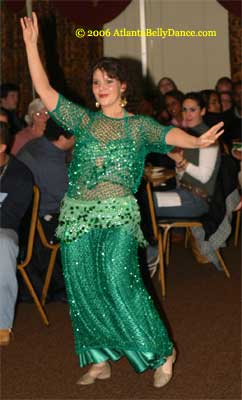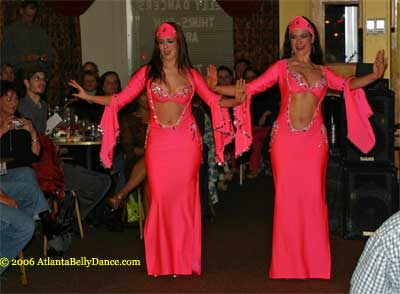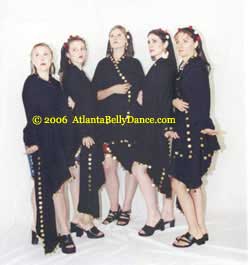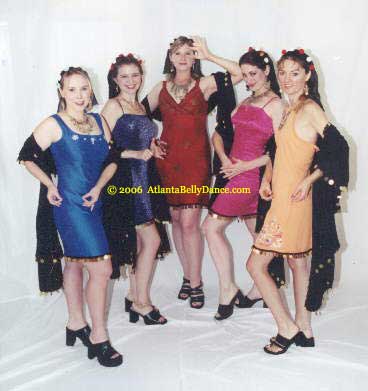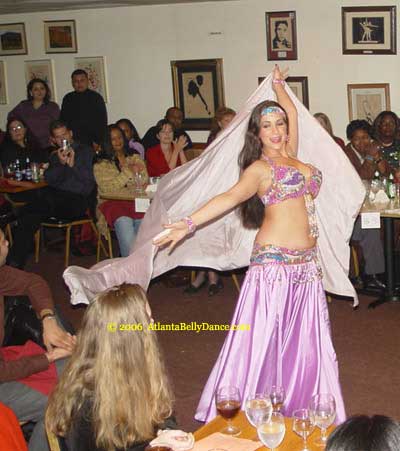
|

|
|||||||||||||
Egyptian Folkloric style belly dancingIn Egypt, these three main forms of the traditional dance: Beledi/Baladi, Sha'abi, and Sharqi (see Cabaret) are associated with belly dance. The location and occation make a big difference in how dancers are perceived. For example, Dancers at weddings are seen differently to dancers in nightclubs "at weddings, for instance, a dancer occasionally performs in front of the couple and puts her hands on her belly and breasts while she rolls her belly and moves her breasts. I expected this to be considered outrageous behaviour. Yet several people explained that it was innocent merriment and fun. A nightclub dancer who exhibited the same behaviour lacking the context of a happy occasion and working in an atmosphere of sexual excitement, would be considered prostituting herself to earn money".Beledi / BaladiBeledi (pronounced “BE-LE-DEE”) means “of the country” and is a style of Egyptian dance form the early 20th century which is still very popular. Thus, ‘Egyptian Beledi’ means ‘of the country of Egypt’. It came about when farmers moved to the city and began dancing in small spaces. The music also changed and Western instruments such as saxophone and acc ordian were used. Baladi is the most common style of dance in Egypt today and is used to dance to all sorts of music, including Western pop and Al Jeel. Women dance this style at haflas, weddings, at home and in clubs. It is seen on TV and in the theatre. It brings women together and can also be flirtatious and celebratory as well as emotional. At weddings "even people who never dance, the happiness in their hearts makes them stand up and dance the baladi dance".A Beledi dance is performed to earthy music based on the easy-to-dance-to Beledi rhythm. Often the Beledi rhythm and the Saidi rhythm are played interchangeably. A Beledi dance from the region of Cairo includes vocals, and may involve a question-and-answer play between two instruments or between the vocals and the instruments. Beledi DressThe beledi dress could be used for cane dance, beledi, Persian Bandari or in a pinch as a cover up. Try it over harem pants or circle skirt for a different look.
Saidi - Raks Assaya - Cane danceIn Upper Egypt there is a more complex dance called Saidi which is more competitive and is sometimes danced with a stick. The women use the stick in imitation of the men's stick dance which is very martial, and make it more flirtatious. The Bedouin and Nubian women also dance and this is for celebration and can be competitive. The musical accompaniment (often just singing, clapping and maybe a drum) will stop when the watchers are fed up with a dancer. There has not been much research on either Bedouin or the Nubian dance, particularly the latter since the Aswan dam displaced the people. However both kinds of dance use shuffling steps and jumps.The Saidi (pronounced SIGH-EE-DEE) dance is from Upper Egypt, between Gizeh and Edfu. Usually a Saidi dance is lively, energetic and earthy, using the 4/4 rhythm known as the Saidi rhythm. The dancer uses one or two sticks, originally made of bamboo. There are two types of Saidi stick dance: Raks Assaya and the Tahtib. The Tahtib is performed by two men and depicts a dance of combat and the handling of weaponry. Raks Assaya is performed by men and/or women and shows off a more acrobatic version of handling the stick.
Melaya LeffThere is a type of character dance done by Egypt's folk troupes known as melaya lef which uses a shawl-type of garment known as a melaya as a prop. In the melaya lef folkloric dance, the dancer plays the role of a mischievous young woman who flirtatiously plays a "conceal and reveal" game with her wrap.
Beledi music is used specifically for the Melaya Leff (pronounced “ME-LIE-AH LEF”). The dance itself is from Alexandria, Egypt. A melaya itself is a large, black shawl made of nylon or silk, in which the women wrap themselves completely from head to toe. It is a modesty garment for when they leave the house. For the stage, the melaya is trimmed with gold or silver pailettes. The word leff simply means “to wrap”. Under the melaya, the dancer wears a form-fitting dress that is short, ruffled and bright in color. She dons open-toed slippers with high heels called ship-ship, and on her head she ties a small scarf decorated with pompons or flowers. Also worn is a crocheted face-veil known as a burr’oh. The melaya is draped upon the body, and during the dance it slips off and is re-wrapped time and again. As Alexandria is a port city, the dance scene is between the fishermen and the women who are looking to profit by sharing their liberties. The men sit on the street beside a café, drinking and smoking their water pipes. The women compete for attention by flirting. Eventually, the men and women dance together. The men’s costuming is that of the typical fisherman, including a black trouser, a sweater, a multi-colored waistcoat and a white fisherman’s hat. In Egypt, an Oriental dancer might use the melaya lef dance for the folkloric part of her show, but she doesn't do so wearing her Oriental costume. In the U.S., since most Americans doing Egyptian style dances don't have the opportunity to do a costume change after the Oriental set and come back out in folkloric costume, they rarely use the melaya lef in their Oriental performances. Sha'abiSha'abi is the general term for all those dances performed by peasants in the countryside. It bonds the community together and happens during celebrations, such as weddings and can also be flirtatious although the men and women do not dance together. (6). Sha'abi is also a name for some of the less traditional but earthy music which is popular in Egypt today. Egyptians will dance to this music in clubs and it can be political. This can be an example of negative community bonding, such as the popular hit "I (explicit deleted) Israel". Rai is a similarly revolutionary music which means "opinion" and is also popular among young people, and again, can be political. It is a little like punk with its lyrics and changing of traditional music, blending it with jazz instruments and funky guitars and synthesisers. This is danced to in clubs and at home and bonds young and disaffected people together. Traditional dance movements may be combined with steps seen on television such as jazz steps from Western pop videos.FellahinThe Fellahin (pronounced “FE-LAH-HEEN”) are the farmers of Egypt. A Fellahi dance uses the Fellahi rhythm, which is quick, light and very similar to the malfoof rhythm. The music always includes vocals, and the dance movements follow those vocals. A Fellahi dance depicts the everyday work of the farmers, such as gathering food in a basket and collecting water in jugs. The costuming for women includes a loose, long dress that is ruffled at the bottom and very wide, along with a veil worn on the head. Sometimes a long scarf is worn around the neck, which the dancer may tie around her hips during the dance to make her hip movements more visible.Egyptian Oriental "Piece of Fabric" - Veil DanceSometimes Egyptian Oriental dancers enter carrying "a piece of fabric" to music that is very fast and dramatic. While Americans refer to this piece of fabric as a "veil", it's important to note that Egyptians do not link the fabric prop to the hijjab (Muslim attire). Therefore, it's not exactly correct to refer to the prop carried by Egyptian Oriental dancers as a "veil" because that's not how they view it, culturally speaking.
Al JeelAl Jeel is the term for popular modern Egyptian music which is danced to at home, in clubs and at weddings when there is a sound system (especially weddings in Western countries). In the home it will usually be just women and girls dancing together but still can be flirtatious and showy. A hafla is an Egyptian party and here the women will dance together away from the men. This brings the women closer, gives them a feeling of support and lets them let their hair down. The Zeffa is an Egyptian wedding procession headed by the bride and groom who are then entertained by music and dancing. After the professional dancers have gone the guests may themselves dance. Traditionally for good luck there is a professional dancer who wears a shamadam (candelabra) on her head.
SharqiSharqi is the classical dance that cabaret is based on. It originated in the Ottoman empire and takes up lots more space. It is seen on stage and on TV, especially the old Egyptian films of the 30's and 40's where cabaret style began. This is the style the West is most familiar with and the Hollywood-inspired bra and belt costume is often worn. It started off in the courts and has remained the most refined of the Egyptian dances. The music is more emotional and spiritual so it appeals to women who want to show depths of feeling. It is not really danced to just for fun because it is more balletic than earthy so most Egyptian women would be more likely to watch it than do it. Because it is more an artistic expression than an entertainment, it is far more appealing to Wes tern audiences. Unlike Sha'abi and Baladi styles where it is easy to dance in a crowded small space, it is suited to the stage.American dancers performing Egyptian Oriental style sometimes do an Egyptian-style veil entrance, although some American dancers might swirl the veil around a bit more than what most Egyptians are likely to do. Dahiya Egyptian Scarf DanceDahiya is a version of the haggallah dance of Upper (central) Egypt which was introduced to Vancouver in the late 70s by Denise Enan. The dance features lots of hip and shoulder shimmies as the dancers wave colourful hankies to accent flirtatious and saucy moves.Ghawazee - Egyptian Gypsy DanceThe Ghawazee are a family of dancers with their own distinct style of dancing passed on from mother to daughter. It is believed they were originally a tribe called the Nawara that came to Egypt possibly from Persia.The men of the family play music and the women’s performances at festivals, weddings and private parties support the family. The movement vocabulary is more limited and repetitive than a raks sharqi routine but the dancers are able to continue their mesmerizing shimmies and zill playing for hours.
Sources:
|

